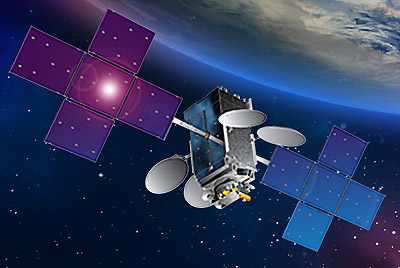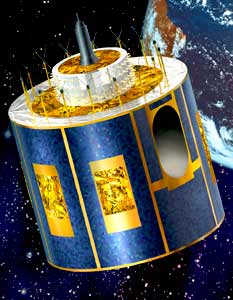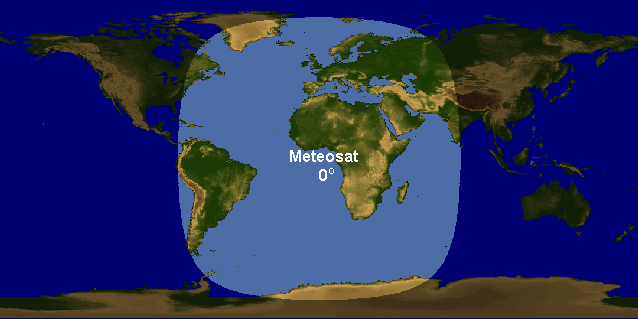



In celebration of New Horizons finally reaching Pluto, two of my favorite rockets are flying today!
The 80th Ariane 5 rocket has a rather special passenger on its lower berth this time – the 11th Meteosat geostationary orbit weather satellite for Europe and probably one of the last “spinner satellites” to fly. Being the 4th and final 2nd generation Meteosat, MSG-4 will be one of the last weather satellite that uses the spin-stable attitude control method for self control and maintaining high pointing precision for its weather monitoring purposes. With the advancement of 3-axis stabilizing control methods, communication satellites and weather satellites in geostationary orbit have been gradually giving up the old method of spinning the satellite quickly to maintain their postures and use thrusters/reaction wheels to point, with the weather satellites a bit late in adopting this due to pointing accuracy. Starting from the next one, the 3rd generation Meteosat series will use 3-axis stabilizing satellite buses. Thus MSG-4, due to replace MSG-3/Meteosat 10 launched 3 years ago some time later, will be one of the last of the breed of drum shaped satellites that we all grew up with.
Speaking of the old breed, the passenger on the upper berth is definitely a good example of the “new breed” today. Star One C4 is the newest communication satellite for Brazil’s largest satellite communication operator – which will support direct broadcasting across the 2 continents of the West hemisphere for the 2016 Rio Olympics.
Quite an interesting pairing, I shall say! :hmm:
Launch location:
Kourou Launch pad ELA-3 5° 14'06.34"N, 52° 46'06.34"W
Launch dates and times:
Time Zone |
Paris /CEDT
|
Universal / UTC
|
Kourou / UTC-3
|
Washington / EDT
|
Los Angeles / PDT
Launch time (Primary):
|
23:42:00
|
21:42:00
|
18:42:00
|
17:42:00
|
14:42:00
on:
|
Jul. 15, 2015
|
Jul. 15, 2015
|
Jul. 15, 2015
|
Jul. 15, 2015
|
Jul. 15, 2015
{colsp=6}
[highlight][eventTimer]2015-07-15 21:42:00?before|after;%dd% Days %hh% Hours %mm% Minutes %ss% Seconds %c%[/eventTimer] Ariane flight VA-224 Launch[/highlight]
Live Coverage Of The Launch:
- Arianespace: http://www.arianespace.tv/ (begins at 20 minutes before lift-off)


PAYLOAD 1
Star One C4 communication satellite:

Mission Summary
The Star One C4 satellite was ordered in 2012 from Space Systems Loral by Star One S.A.. The satellite will feature 48 Ku-band transponders.
Star One C4 satellite will be co-located with Star One C2, increasing the Ku-band capacity at that position, ensuring the coverage of the entire Brazilian territory and the expansion of the service to the Western South and Central America, as well as Mexico and mainland United States.
Ku-Band ensures the provision of services, such as video transmission and Internet directly to users, in addition to telephony for remote locations.
Parameter | Value
Working Orbit:
|
GEO
Orbital Location:
|
70° West
Coverage:
|
Brazil, Western South and Central America, Mexico and mainland United States
ApA at separation:
|
35904 km
PeA at separation:
|
249.1 km
Inc at separation:
|
4.0°Star One C4
Customer:
|- Embratel Star One
Prime contractor:
|- Space Systems/Loral

Platform:
|- LS-1300
Mass at Separation:
|- 5565 kg
Dry Mass:
|- ?
Stabilization:
|- 3 axis stabilized
Dimensions (stowed):
|- 5.10 x 2.35 x 2.20 m
Dimensions (deployed span):
|- ?
On-board power:
|- 15 kW at end of life
Communication Payload:
|- 48 Ku-band transponders
Life time:
|- 15 years
Transponders coverage:
||


PAYLOAD 2
MSG-4 (Meteosat 11) meteorology satellite:

Mission Summary
MSG (Meteosat Second Generation) features 12 channels enhanced imaging radiometer (SEVIRI) and the Geostationary Earth Radiation Budget (GERB) instrument.
The high performance of the new generation is 4 times better than the other ones on the market and 10 times better than Meteosat of the first generation.
They will ensure the continuity of current services and supply highly significant advances. The transmission rate of images is doubled (one image every 15 minutes) and the number of spectral channels rise from 3 to 12 (including 8 infrared channels), three allowing for access to comprehensive information on atmospheric physics. Spatial resolution is also enhanced: MSG is able to discern details down to 1 kilometer in a visible highresolution channel and 3 kilometers for the other channels. The general concept is derived from the first generation, but the platform and payload are completely new.
The satellites are being renamed to Meteosat when they become operational.
Parameter | Value
Working Orbit:
|
GEO
Orbital Location:
|
3.4° West
Coverage:
|
Europe, Africa (including Reunion Island), Atlantic Ocean, eastern South America
ApA at separation:
|
35904 km
PeA at separation:
|
249.1 km
Inc at separation:
|
4.0°MSG-4 (Meteosat 11)
Customer:
|- EUMETSAT
Prime contractor:
|- Thales Alenia Space

Platform:
|- Meteosat bus
Mass at Separation:
|- 2043 kg
Dry Mass:
|- ?
Stabilization:
|- Spin stabilized
Dimensions (stowed):
|- Ø 3.2 x 2.3 m
Dimensions (deployed span):
|- ?
On-board power:
|- 0.7 kW at end of life
Payloads:
|- Spinning Enhanced Visible and Infrared Imager (SEVIRI)
- Geostationary Earth Radiation Budget (GERB)
- Search and Rescue signal repeater (SARR)
Life time:
|- 7 years
Instrument coverage:
||


Launch Vehicle:

Ariane 5 ECA
Prime contractor:
|- Airbus Defence and Space (ex-EADS Astrium)

Height:
| 50.5 m with upper stage and payload fairingDiameter:
| max 11.56 mLiftoff mass:
| 780 metric tonnesPayload mass:
| ~10 tonnes at GTO (1500 m/s to GEO)SOLID ROCKET BOOSTER (EAP):
|- 2 X P241 motor
- Empty 38 tonnes
- Propellants 240 tonnes (HTPB)
- Thrust in vacuum 700 tonnes of force
- Thrust at sea level 509.9 tonnes of force
CRYOGENIC MAIN CORE STAGE (EPC):
|- 1 X Vulcain-2 engine
- Empty 14.7 tonnes
- Propellants 170 tonnes (LOX + LH2)
- Thrust in vacuum 139 tonnes of force
- Thrust at sea level 96 tonnes of force
CRYOGENIC UPPER STAGE (ESC-A):
|- 1 X HM7B engine
- Empty 4.54 tonnes
- Propellants 14.9 tonnes (LOX + LH2)
- Thrust in vacuum 6.7 tonnes of force
Payload Fairing:
|- Diameter 5.4 m
- Length 17 m
- Mass 2675 kg
The vehicle's reliability statistics according to http://www.spacelaunchreport.com/log2015.html#rate:
Code:
================================================================
Vehicle Successes/Tries Realzd Pred Consc. Last Dates
Rate Rate* Succes Fail
================================================================
Ariane 5-ECA 48 49 .98 .96 48 12/11/02 2002-
Ariane VA224 Ascent Profile
The launcher’s attitude and trajectory are totally controlled by the two onboard computers, located in the Ariane 5 vehicle equipment bay (VEB).
7.05 seconds after start of the ignition of the main stage cryogenic engine at T-0, the two solid-propellant boosters are ignited, enabling liftoff. The launcher first climbs vertically for 6 seconds, then rotates towards the East. It maintains an attitude that ensures the axis of the launcher remains parallel to its velocity vector, in order to minimize aerodynamic loads throughout the entire atmospheric phase, until the solid boosters are jettisoned.
The fairing protecting the Star One C4 and MSG‑4 spacecraft is jettisoned at T+220 seconds.
Once this first part of the flight is completed, the onboard computers optimize the trajectory in real time, minimizing propellant consumption to bring the launcher first to the intermediate orbit targeted at the end of the main stage propulsion phase, and then the final orbit at the end of the flight of the cryogenic upper stage.
The main stage falls back off the coast of Africa in the Atlantic Ocean (in the Gulf of Guinea). On orbital injection, the launcher will have attained a velocity of approximately 9,365 meters/second, and will be at an altitude of about 643.2 kilometers.
Ariane VA224 Ascent Timeline
Start of synchronized sequence|-00:07:00|21:35:00|
Ignition of the cryogenic main stage engine (EPC)|00:00:00|21:42:00|
Liftoff (Ignition of solid boosters)|00:00:07.3|21:42:07.3|
End of vertical climb and beginning of pitch rotation (10 seconds duration)|00:00:12.6|21:42:12.6|
Beginning of roll manoeuvre|00:00:17.0|21:42:17.0|
Jettisoning of solid boosters|00:02:22|21:44:22|
Payload Fairing Separation|00:03:43|21:45:43|
Shut-down of main cryogenic stage|00:08:49|21:50:49|
Separation of main cryogenic stage|00:08:55|21:50:55|
Ignition of upper cryogenic stage (ESC-A)|00:08:59|21:50:59|
End of first ESC-A thrust phase / Injection|00:24:48|22:06:48|
Separation of Star One C4 satellite|00:28:15|22:10:15|
Separation of Sylda 5|00:30:56|22:12:56|
Separation of MSG-4 satellite|00:40:19|22:22:19|



Weather forecast for Kourou, French Guiana on July 15, 2015 (6 p.m.)
Scattered thunderstorms in the morning, then mainly cloudy during the afternoon with thunderstorms likely. High 29C. Winds E at 10 to 15 km/h. Chance of rain 80%.
6 PM|27°C|23°C|78%|46%|0%|50%|1012 hPa|10 km/h E|
References
http://www.arianespace.com
http://www.arianespace.tv
http://www.eumetsat.int/website/home/MSG4/
http://www.starone.com.br/en/
http://www.arianespace.com/images/launch-kits/launch-kit-pdf-eng/VA224-launchkit-GB.pdf
http://english.wunderground.com/q/zmw:00000.1.81403?
http://forum.nasaspaceflight.com
http://www.spacelaunchreport.com
http://space.skyrocket.de

























